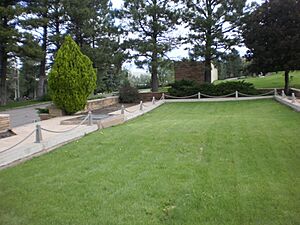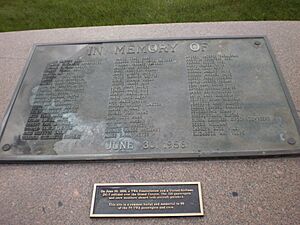1956 Grand Canyon mid-air collision facts for kids
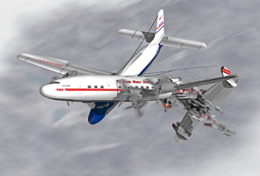
Illustration of the collision
|
|
| Accident summary | |
|---|---|
| Date | June 30, 1956 |
| Summary | Mid-air collision due to inadequate ATC system |
| Place | Grand Canyon, Arizona, U.S. |
| Total fatalities | 128 |
| Total survivors | 0 |
| First aircraft | |
 A United Airlines DC-7, similar to the aircraft involved |
|
| Type | Douglas DC-7 Mainliner |
| Name | Mainliner Vancouver |
| Airline/user | United Airlines |
| Registration | N6324C |
| Flew from | Los Angeles Int'l Airport |
| Flying to | Chicago Midway Airport |
| Passengers | 53 |
| Crew | 5 |
| Fatalities | 58 |
| Survivors | 0 |
| Second aircraft | |
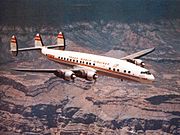 The Lockheed L-1049A Super Constellation involved |
|
| Type | Lockheed L-1049A Super Constellation |
| Name | Star of the Seine |
| Airline/user | Trans World Airlines |
| Registration | N6902C |
| Flew from | Los Angeles Int'l Airport |
| Flying to | Kansas City Downtown Airport |
| Passengers | 64 |
| Crew | 6 |
| Fatalities | 70 |
| Survivors | 0 |
The Grand Canyon mid-air collision happened in the western United States on June 30, 1956. A United Airlines Douglas DC-7 plane crashed into a Trans World Airlines Lockheed L-1049 Super Constellation plane. This happened over Grand Canyon National Park, Arizona.
One plane fell into the canyon, and the other hit a rock face. All 128 people on both airplanes died. This was the first time more than 100 people died in a commercial airline accident. The planes had left Los Angeles International Airport only minutes apart. One was going to Chicago, and the other to Kansas City.
The crash happened in an area of the sky called "uncontrolled airspace." In these areas, pilots were responsible for keeping their planes safely apart. This event showed that the air traffic control system was old-fashioned. It led to big changes in how airplanes are managed in the sky.
Contents
How the Flights Started
TWA Flight 2: The Star of the Seine
Trans World Airlines Flight 2 was a Lockheed L-1049 Super Constellation plane. Its nickname was Star of the Seine. The pilot was Captain Jack Gandy, 41 years old. First Officer James Ritner (31) and Flight Engineer Forrest Breyfogle (37) were also on board.
The plane left Los Angeles on Saturday, June 30, 1956, at 9:01 am PST. It had 64 passengers and six crew members. It was heading to Kansas City Downtown Airport. The flight was 31 minutes late.
Flight 2 first flew using instrument flight rules (IFR). This means air traffic control guided it. It climbed to an altitude of 19,000 feet (5,800 m). It stayed in controlled airspace until Daggett, California. After Daggett, Captain Gandy turned right. The plane was now "off airways," flying in uncontrolled airspace.
United Airlines Flight 718: The Mainliner Vancouver
United Airlines Flight 718 was a Douglas DC-7 plane. Its nickname was Mainliner Vancouver. The pilot was Captain Robert "Bob" Shirley, 48 years old. First Officer Robert Harms (36) and Flight Engineer Girardo "Gerard" Fiore (39) were also on board.
This plane left Los Angeles at 9:04 am PST. It had 53 passengers and 5 crew members. It was going to Chicago's Midway Airport.
Flight 718 climbed to an altitude of 21,000 feet (6,400 m). Captain Shirley also flew under IFR in controlled airspace. He flew to a point northeast of Palm Springs, California. Then, he turned left toward a radio beacon near Needles, California. After that, his plan was to fly directly to Durango, Colorado. Like the TWA plane, United's DC-7 was now flying in uncontrolled airspace.
Changing Flight Plans
Soon after taking off, TWA's Captain Gandy asked to climb to 21,000 feet. He wanted to avoid thunderheads (big storm clouds) in his path. At that time, pilots did not talk directly to air traffic control (ATC) after takeoff. So, his request went through a TWA flight dispatcher.
ATC said no to his request. The two planes would soon re-enter controlled airspace. ATC could not keep planes at the same altitude safely apart.
Captain Gandy then asked for "1,000 on top" clearance. This meant flying 1,000 feet (300 m) above the clouds, in clear weather. ATC approved this. This clearance meant the Constellation was still under IFR. But ATC would not keep it separate from other planes. Captain Gandy and First Officer Ritner were now responsible for seeing and avoiding other aircraft. This was called "see and be seen."
This "see and be seen" rule is useful near airports when the weather is clear above clouds. But it was less common for planes flying long distances.
After getting "1,000 on top" clearance, Captain Gandy climbed to 21,000 feet (6,400 m). Both planes were now at the same altitude. Both pilots thought they would cross the Painted Desert line around 10:31 am Pacific time. This line was about two hundred miles (320 km) long. It was completely outside controlled airspace.
As the planes got closer to the Grand Canyon, they were at the same height and almost the same speed. The pilots were probably flying around tall clouds. The Constellation's clearance meant it had to stay in clear air, above the clouds. It is thought that the planes passed the same cloud on opposite sides.
The Collision
Around 10:30 am, the two planes crashed into each other over the canyon. They hit at an angle of about 25 degrees. After the crash, experts figured out that the United DC-7 was turning right and pointing down. This suggests that one or both United pilots saw the TWA Constellation. They likely tried to move out of the way.
The DC-7's raised left wing hit the top of the Constellation's vertical stabilizer (tail fin). It also hit the main body of the plane right in front of the tail. This caused the entire tail section to break off the Constellation.
At the same time, the propeller on the DC-7's left outer engine cut several gashes into the bottom of the Constellation's body. Air rushed out of the Constellation very quickly. This is called Explosive decompression. Small pieces of the plane and personal items were spread over a large area. This showed how much damage there was.

When the tail broke off, the Constellation lost control immediately. It went into a very fast, almost straight-down dive. The Constellation crashed into the north side of a ravine near Temple Butte in the Grand Canyon. It hit the ground at over 700 feet per second (410 kn; 480 mph; 770 km/h). The plane broke apart on impact, killing everyone on board instantly. A large fire started, fed by aviation gasoline. The broken tail section, though damaged, was found nearby.
The DC-7's left wing was badly damaged by the crash. It could no longer create enough lift to keep the plane in the air. Its left engine was also severely damaged. With less lift and power, the damaged plane began to spiral down to the left. It was impossible to save it. The Mainliner crashed into the south side cliff of Chuar Butte and broke apart. Everyone on board died instantly.
After the Crash
Finding the Wreckage
The sky over the canyon had no radar to watch planes. Neither plane had homing beacons, cockpit voice recorders, or flight data recorders. The last reports from the planes did not show where they were when they crashed. Also, no one saw the crash happen.
The only sign of trouble was a jumbled radio message from Flight 718. United Airlines radio operators in Salt Lake City and San Francisco heard it. It was the last message from either plane. Investigators later listened to the message, which was saved on magnetic tape. They heard co-pilot Robert Harms say, "Salt Lake, [ah], 718 ... we are going in!" They also heard Captain Shirley's voice in the background, yelling, "[Pull] up! [Pull] up!" He was likely trying to control the plane.
When neither flight reported its position for a while, they were declared missing. Search and rescue teams began looking for them. The wreckage was first spotted later that day. It was near where the Colorado and Little Colorado Rivers meet. Henry and Palen Hudgin, two brothers who ran a small air taxi service called Grand Canyon Airlines, found it. Earlier that day, Palen had seen thick black smoke near Temple Butte. This was where the Constellation crashed. But he thought it was just a brush fire caused by lightning.
When Palen heard about the missing planes, he thought the smoke might have been from a crash fire. He and his brother flew a small plane (a Piper Tri-Pacer) deep into the canyon. They searched near where he saw the smoke. They found the Constellation's empennage (tail section). The brothers told the authorities what they found. The next day, they found the wreckage of the DC-7.
Many helicopter missions flew down to the crash sites. They tried to find and identify victims. They also recovered parts of the planes for the investigation. This was hard and dangerous work because the area was very rugged. The air currents were also unpredictable.
A Swiss air rescue team and mountain climbers were hired by the airlines. They went to the crash sites to gather remains and personal items. This was widely reported in the news because of how difficult the terrain was.
Because of the extreme force of the impacts, it was very hard to identify most of the remains. On July 9, 1956, a memorial service was held for the TWA Flight 2 victims at the canyon's south rim. Twenty-nine unidentified victims from the United flight were buried in four coffins at the Grand Canyon Pioneer Cemetery. Sixty-six of the seventy TWA passengers and crew are buried together in a mass grave at Citizens Cemetery in Flagstaff, Arizona. It took many years to remove most of the wreckage from the canyon. Some pieces of the planes are still at the crash sites today.
The Investigation Begins
Jack Parshall led the investigation into this accident. It was very difficult because the crash sites were far away and hard to reach. Also, the planes were almost completely destroyed. There were no modern flight recorders to give real-time information.
Despite these challenges, experts from the Civil Aeronautics Board (CAB) were able to figure out what likely happened. In their report, they stated the main reason for the accident:
The Board believes the main reason for this mid-air crash was that the pilots did not see each other in time to avoid hitting each other. It is not possible to know why the pilots did not see each other. But the evidence suggests it was because of one or more of these reasons: clouds blocking their view, limited visibility from the cockpit, being busy with normal pilot duties, being busy with things not related to flying (like trying to give passengers a better view of the Grand Canyon), human eye limits making it hard to see the other plane in time, or not enough air traffic advice because of poor equipment and too few people in air traffic control.
The report said that weather and the condition of the planes were not causes of the accident. Since there were no witnesses and it was unclear how well pilots could see at high altitudes, it was impossible to know exactly how much time the pilots had to see and avoid each other.
The CAB did not blame either flight crew directly. However, TWA's Captain Gandy decided to cancel his IFR flight plan and fly "1,000 on top." This was likely a key factor in the accident. The investigation was very thorough. But the final report focused on technical issues. It did not look much at human factors. For example, it did not explain why airlines let pilots fly maneuvers just to give passengers a better view of the canyon. It was not until the late 1970s that human factors became a big part of accident investigations.
During the investigation, Milford "Mel" Hunter, an artist for Life magazine, was given early access to the CAB's information. This allowed him to draw what probably happened during the collision. Hunter's detailed painting appeared in Life magazine on April 29, 1957. It was also included in David Gero's book Aviation Disasters II.
In a letter to Gero in 1995, Hunter wrote:
I was able to map the two flight paths and see that both planes were in each other's blind spot. I remember showing that the propellers of the plane flying down cut gashes along the top of the plane flying up. I did a lot of this kind of factual re-creation for Life. They were always very hard to put together to satisfy all the editors, art directors, and researchers. But it was very interesting work.
Hunter's memory of his drawing was not completely correct. The painting showed the DC-7 below the Constellation. It showed the DC-7's first engine under the Constellation's body. This did not match what the CAB found.
Big Changes After the Crash
At 128 deaths, the Grand Canyon collision was the deadliest commercial airline disaster in the U.S. at that time. It was also the deadliest air crash of any kind on U.S. soil. It was later surpassed on December 16, 1960, by the 1960 New York mid-air collision. That crash also involved United and TWA planes. It also caused 128 deaths in the air, plus 6 deaths on the ground.
News of the Grand Canyon accident spread worldwide. People learned how basic air traffic control (ATC) was. They also learned that little was being done to make it better. The air traffic controller who cleared TWA to fly "1,000 on top" was criticized. He had not told Captains Gandy and Shirley about the possible danger of other planes. Both airlines and the press blamed him. But he was cleared of any wrongdoing. Charles Carmody, who was an assistant ATC director, said that neither flight was legally under ATC control when they crashed. Both were "off airways." The controller was not required to warn the pilots about other planes. The CAB report stated that the controller did tell TWA's ground radio operator about United 718. The TWA operator said Captain Gandy heard this information.
The accident was especially worrying because people had started to trust air travel more in the 1950s. New planes like the Super Constellation, Douglas DC-7, and Boeing Stratocruiser made flying seem normal. Big companies used air travel often. People on vacations often chose to fly instead of taking the train. At the time, a congressional committee was looking into domestic air travel. There was growing concern about the number of accidents. But little progress was being made. The ATC system at the time of the Grand Canyon accident was still using methods from the 1930s.
As near-misses and mid-air collisions kept happening, the public demanded action. There were often heated hearings in Congress. In 1957, more money was given to update ATC. This money helped hire and train more air traffic controllers. It also helped buy much-needed radar equipment, often old military equipment.
However, control of American airspace was still split. The military and the Civil Aeronautics Administration (CAA) shared control. The CAA was the federal agency in charge of air traffic control. But it had no power over military flights. Military planes could enter controlled airspace without warning other planes. This led to more near-misses and crashes between civilian and military planes. Military planes often flew much faster. For example, in 1958, United Airlines Flight 736 crashed with an F-100 Super Sabre fighter jet near Las Vegas, Nevada. This crash killed 49 people.
Again, people demanded action. After more hearings, the Federal Aviation Act of 1958 was passed. This law got rid of the CAA. It created the Federal Aviation Agency (FAA). The FAA was later renamed the Federal Aviation Administration in 1966. The FAA was given complete control over American airspace, including military flights. As procedures and ATC facilities were updated, mid-air collisions became less common.
In 1960, a jury in Kansas City ruled against United Airlines. They awarded money to the families of the TWA pilots. Jack S. Gandy's family received $64,000. James H. Ritner's family received $45,000.
A Historic Landmark
|
1956 Grand Canyon mid-air collision
|
|
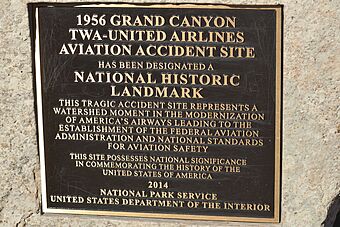 |
|
| Location | Coconino County, Arizona |
|---|---|
| NRHP reference No. | 14000280 |
| Added to NRHP | April 22, 2014 |
On April 22, 2014, the crash site was named a National Historic Landmark. This was the first time a place where an event happened in the air was given this honor. The location is in a remote part of the canyon. Only hikers can reach it. It has been closed to the public since the 1950s.
Stories and Shows About the Crash
The story of this disaster has been featured in several TV shows:
- In 2006, the History Channel show UFO Files covered it in an episode called "Black Box UFO Secrets."
- In 2010, the National Geographic Channel show Mayday (also known as Air Emergency and Air Crash Investigation) featured the story. The episode was called "System Breakdown." In 2013, another episode from the same show, "Grand Canyon Disaster," also covered it.
- It was in season 1, episode 5, of the TV show Why Planes Crash, in an episode called "Collision Course."
- In 2015, the Travel Channel show Mysteries at the National Parks featured the crash in its seventh episode, "Portal To The Underworld." It was even mentioned as a "supernatural event."
- In 2014, the Smithsonian Channel show "Air Disasters" covered the event and investigation in episode 4 of season 6, titled "Grand Canyon."
See also
 In Spanish: Colisión aérea en el Gran Cañón de 1956 para niños
In Spanish: Colisión aérea en el Gran Cañón de 1956 para niños



